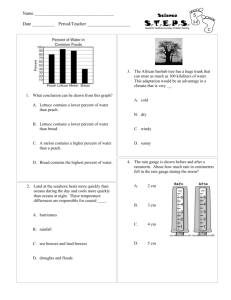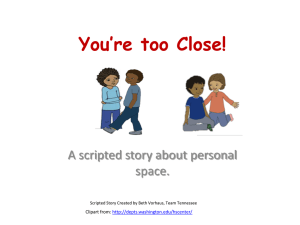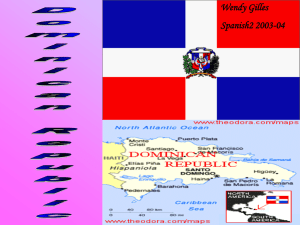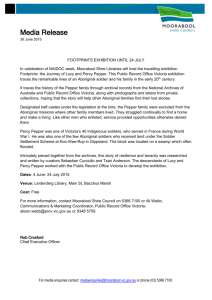SCARED PEPPER
advertisement
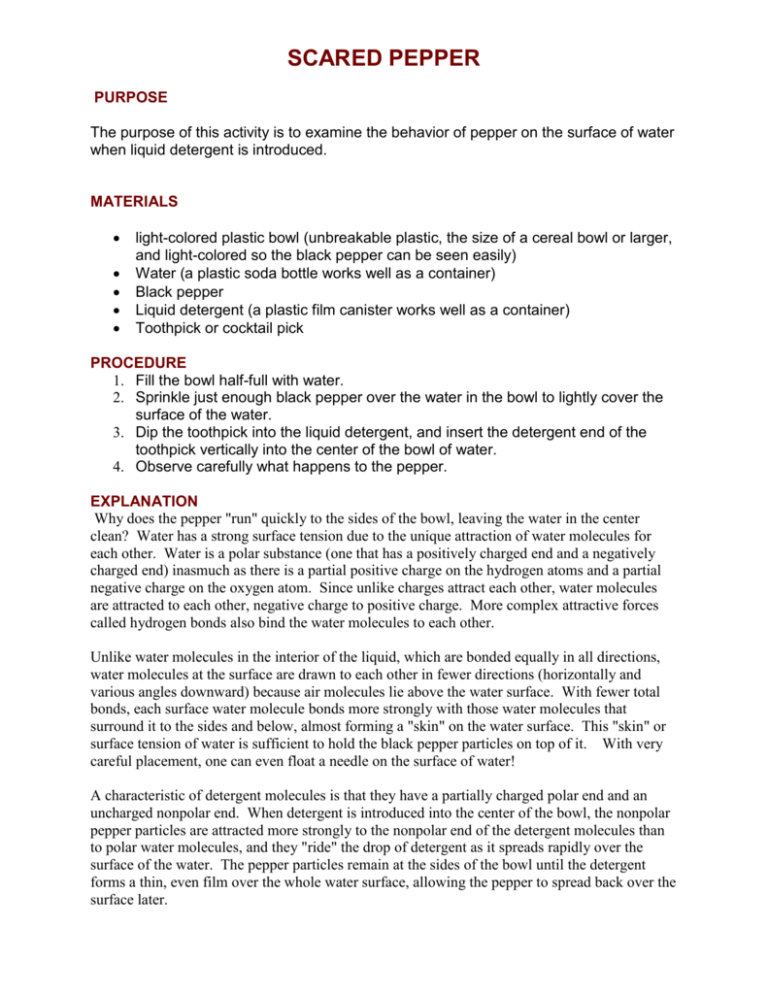
SCARED PEPPER PURPOSE The purpose of this activity is to examine the behavior of pepper on the surface of water when liquid detergent is introduced. MATERIALS light-colored plastic bowl (unbreakable plastic, the size of a cereal bowl or larger, and light-colored so the black pepper can be seen easily) Water (a plastic soda bottle works well as a container) Black pepper Liquid detergent (a plastic film canister works well as a container) Toothpick or cocktail pick PROCEDURE 1. Fill the bowl half-full with water. 2. Sprinkle just enough black pepper over the water in the bowl to lightly cover the surface of the water. 3. Dip the toothpick into the liquid detergent, and insert the detergent end of the toothpick vertically into the center of the bowl of water. 4. Observe carefully what happens to the pepper. EXPLANATION Why does the pepper "run" quickly to the sides of the bowl, leaving the water in the center clean? Water has a strong surface tension due to the unique attraction of water molecules for each other. Water is a polar substance (one that has a positively charged end and a negatively charged end) inasmuch as there is a partial positive charge on the hydrogen atoms and a partial negative charge on the oxygen atom. Since unlike charges attract each other, water molecules are attracted to each other, negative charge to positive charge. More complex attractive forces called hydrogen bonds also bind the water molecules to each other. Unlike water molecules in the interior of the liquid, which are bonded equally in all directions, water molecules at the surface are drawn to each other in fewer directions (horizontally and various angles downward) because air molecules lie above the water surface. With fewer total bonds, each surface water molecule bonds more strongly with those water molecules that surround it to the sides and below, almost forming a "skin" on the water surface. This "skin" or surface tension of water is sufficient to hold the black pepper particles on top of it. With very careful placement, one can even float a needle on the surface of water! A characteristic of detergent molecules is that they have a partially charged polar end and an uncharged nonpolar end. When detergent is introduced into the center of the bowl, the nonpolar pepper particles are attracted more strongly to the nonpolar end of the detergent molecules than to polar water molecules, and they "ride" the drop of detergent as it spreads rapidly over the surface of the water. The pepper particles remain at the sides of the bowl until the detergent forms a thin, even film over the whole water surface, allowing the pepper to spread back over the surface later. ADDITIONAL SUGGESTIONS To determine the validity of the explanation (theory or hypothesis) above or to devise their own explanation, encourage students to suggest additional experiments to test the theory and explore why the pepper went to the sides of the bowl rather than to the bottom. Don't spoon-feed the students with ideas. Some of the following experiments and many more could be tried either in school or at home with parents participating. Some of the following additional supplies may be needed as well as others. Red food coloring Thyme Raspberry or strawberry gelatin Cooking oil 1. Add more than 1 drop of detergent to see if the surface tension of the water is decreased sufficiently to allow the pepper to sink through the surface. (The pepper doesn't sink.) 2. Add a second drop of detergent to one side of the bowl where the pepper accumulated to see if the pepper is riding the top of "clean water" which had not sufficiently had its surface tension decreased by the detergent. (The pepper does not sink; it was not riding clean water.) 3. Add detergent originally at one side of the bowl instead of in the middle. (The pepper "runs" to the other side of the bowl.) 4. Add initially 2 drops of detergent simultaneously on opposite sides of the bowl. (Two rings of pepper particles form, with a common side in the middle.) 5. Add red food coloring to the detergent to see if the detergent forms a film across the entire surface of the water. (A film cannot be seen, but some of the red food coloring sinks to the bottom of the bowl.) 6. Sprinkle thyme over the surface of the water to see if pepper was unique in its behavior. (Thyme behaves in the same manner as pepper.) 7. Sprinkle raspberry or strawberry gelatin over the surface of the water to see if a substance known to be attracted to water behaves in same as pepper. (Some gelatin sinks; some floats and behaves in the same manner as pepper.) 8. Use several drops of cooking oil in place of the pepper in the activity. (The drops coalesce or come together in the water initially, and then rapidly disperse when detergent is added. Some of the detergent seems to disappear.) 9. After adding several drops of cooking oil to the water, sprinkle pepper onto the surface of the oil "glob" which forms on the surface to see if the pepper is attracted more strongly to the oil or the water. (The pepper stays with the oil glob when the detergent is added.) Pour a small amount of detergent into a small bowl. Sprinkle pepper over the surface of the detergent. Add a medicine dropper or two of water to the bowl to see if pepper is attracted more strongly to water or to detergent. (The pepper spreads out and stays with the detergent as the water forms a "pool" in the center of the bowl.) Have students bring their ideas together and decide what their results have shown. REFERENCE 1. WonderScience, Fun Physical Science Activities for Children and Adults to Do Together, James H. Kessler, editor, American Chemical Society, Washington, DC, October, 1989, volume 3, number 3, p. 5; James H. Kessler and Andrea Bennett, The Best of WonderScience, Over 400 Hands-on Elementary Science Activities, Delmar Publishers, Albany, NY, 1997, p. 125.


